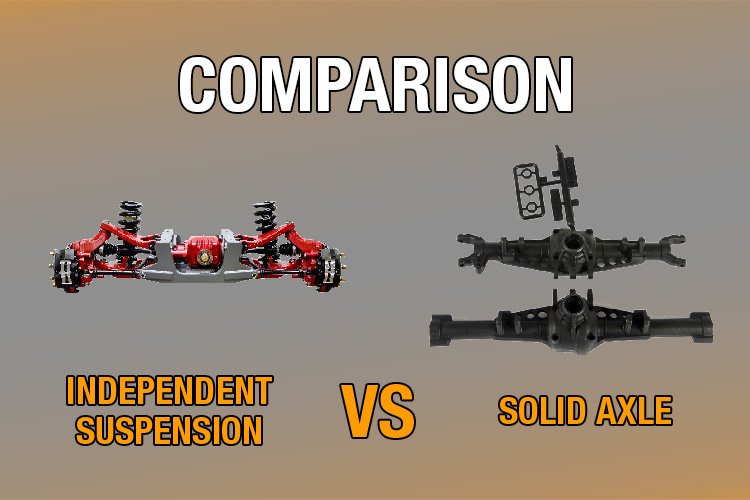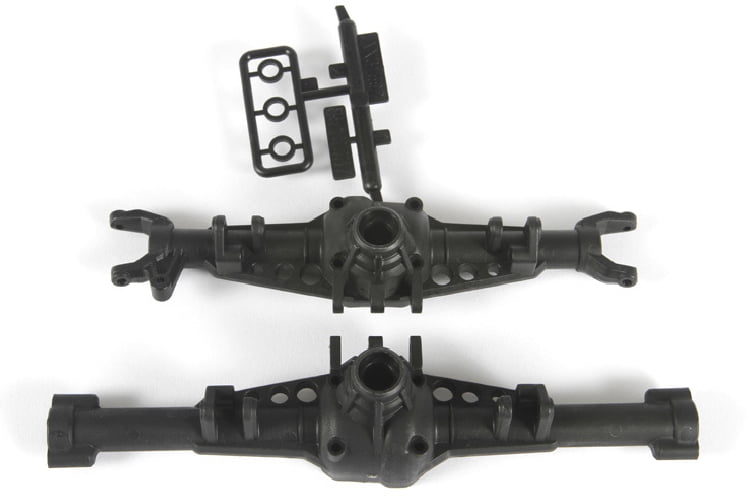The ongoing argument among off-road enthusiasts regarding independent suspension versus solid axle suspension continues. Nevertheless, the importance of a high-quality suspension system for secure and relatively enjoyable off-road and highway performance is undeniable.
A solid axle suspension essentially features a solid axle that physically connects the components of two wheels to the same housing. This is why the wheel’s movement on one side directly affects the wheel on the other side.
On the other hand, an independent suspension setup allows each wheel to move independently of the other.
Both suspension setups have advantages and disadvantages, and we’ll break down the peculiarities. In this article, I will tell you the differences between Independent Suspension and Solid Axle.

Understanding Independent Suspension And Solid Axle
What Is An Independent Front Suspension?

Credit: ads-cz.com
Independent Front Suspension (IFS) is a higher-tech setup that features a comprehensive axle housing for the carrier and ring gear.
CV (Constant Velocity) axles are used in axle tubes with solid axle suspensions. It typically features upper and lower control arms connected to each wheel in a setup that allows the wheels on either side to move up and down without each other.
As a result, the driver experiences smoother handling and control in off-road conditions. This setup also allows faster speeds in off-road terrains. Nowadays, almost all SUVs, all ½-ton and compact pickup trucks, many of the ¾ and 1-ton pickups come with independent front suspensions.
What Is A Solid Front Axle?

Credit: axialracing.com
A solid front axle, also known as a live axle or beam axle, is a stable continuous beam that connects with two wheels on both ends.
At impact, the beam bends slightly between the two wheels, allowing them to move vertically as much as needed. A vertical movement of one wheel in a solid front axle suspension will directly affect the wheel on the other side.
The mechanism is not as high-tech and fanciful as the independent front suspension, but it’s a great example of a classic functional piece of engineering. You’ll find the solid front axle suspension on popular vehicles like the Jeep Wrangler and Ford Bronco.
Read more: Torsion Axle Vs. Leaf Spring: Which One Is Better?
The Differences Between Independent Suspension And Solid Axle
Independent Suspension And Solid Axle Comparison Chart
| Independent Suspension | Solid Axle | |
|---|---|---|
| Handling | Ensures superior handling | Not as good |
| Comfort | Way more comfortable | Not as comfortable |
| Wheel Alignment | Better wheel alignment | Not as good |
| Ground Clearance | Generally has more under-vehicle clearance | The diff pumpkin hangs pretty low, so it has less ground clearance |
| Strength | Can’t handle as much off-road punishment as a solid axle | Stronger and can withstand off-road impacts better |
| Heavy Loads | Not particularly designed to carry a heavy load | Built to handle more weight |
| Differential Centers And Unsprung Weight | Weaker diff centers and lower unsprung mass | Stronger diff centers and can handle more unsprung mass |
| Modification | Limited suspension lift options and not so easy to modify | Bigger suspension lift options and easy to modify |
| Repair | Harder and more expensive to repair | Cheaper and easier to maintain |
| At Speed In Off-Road Race | Faster for off-road races | Not as fast in off-road races |
| Weight And Fuel Economy | Generally lighter and have better fuel economy | Heavier and use more fuel |
Handling
The solid axle is based on a much older technology than the independent suspension, and as such, it provides less comfortable handling. Many drivers would say it handles as stiff as a boat.
The IFS, being a much newer technology, is more tailored towards improved driver experience. It handles way better than the solid axle in both on and off-road conditions.
Comfort
As you can probably guess, an IFS vehicle is way more comfortable than a solid axle vehicle. One of the advantages of the modern independent suspension system is that it considerably improves driver comfort.
Let’s say you hit a rock or an obstacle on an off-road course, one side of an IFS will absorb the effect of the impact, and the other side will remain relatively stable.
If the same scenario is encountered in a solid axle vehicle, you can expect some kind of movement on both sides. More so, if they are leaf sprung. However, when you have to go through big lifts or big washouts in extreme off-road conditions, a solid axle might offer more flex and win the comfort battle.

Wheel Alignment
Overall, the IFS offers better wheel alignment. It features several moving parts that interact to customize wheel aligning. The caster and camber are all adjustable, making it possible to carry out more adjustments.
However, this advantage makes it easier to knock the IFS wheel alignment out. On the other hand, a solid axle alignment is more rigid and harder to knock out, but it is generally less adjustable. So, wheel alignment on solid axles is not as good as IFS.
Ground Clearance
This is another area where the independent suspension comes out on top. The underbody clearance of the suspension system plays a significant role when driving in off-road conditions. There’s limited ground clearance because the diff pumpkin hangs quite low in a beam axle.
However, the differential in an IFS is more tucked up in the body, thereby making more underbody clearance space available. It is not impossible to create more ground clearance under a solid axle. Putting portal axles will raise the axle and diff housing above the wheel hub and increase the ground clearance.
Strength
With its robust build quality, the live axle has an advantage over the IFS when it comes to sheer strength. This can be quite surprising because the beam axle has fewer and simpler components. But it is this simplicity that gives it the edge. The IFS has many tiny moving parts that can get damaged easily.
Another thing to note is that the solid axle does not connect to the chassis of four-wheel drives. When the axle gets damaged from impact, you can expect the chassis to remain intact. However, this is not the case in IFS vehicles where the setup is generally attached to the chassis.
So, if you’re planning to carry some heavy loads or go through some very extreme off-road trails, a solid axle can handle more punishment without giving out.
Heavy Loads
The IFS axle is not your best bet when you have to carry or tow significantly heavy loads. It is designed with handling and comfort as the more important metrics. Although the live axle is old tech, its setup empowers it to handle more stress. Overall, it has better gross vehicle mass (GVM) and gross combination mass (GCM).
In addition to its strength, the solid axle feels more secure when towing heavy loads as it can better resist the twisting movements generated from the load being towed. Note that the IFS is not entirely useless when carrying loads or towing. It just doesn’t hold up as well as the beam axle.
Differential Centers and Unsprung Weight
In most cases, a live axle vehicle has much stronger components, including the diff center. Components like the wheels, brake assemblies, tires, hub motors, and other components that make up the unsprung weight can be handled better by a beam axle system.
IFS setups cannot handle as much unsprung weight, and they generally come with smaller diff centers and less unsprung weight from the factory. The disadvantage is that additional unsprung weight can provide much-needed traction on off-road trails. Nonetheless, they put less stress on the suspension components, so that’s a plus.
Modification
Off-road lovers love to modify their vehicles, an activity that’s hugely dependent on the suspension system. Perhaps modification is why the old-tech live axles are still very much in use today. Its setup allows easy vehicle lifting and fits bigger tires and other modifications.
There’s much more work involved in lifting an IFS vehicle, and when it’s not done rightly, things can go terrible at the CV joints. In addition, this system can only accommodate limited tire sizes, and the CVs are not always strong enough to roll bigger tires.
IFS modification is not entirely impossible, but you may have to pay through the nose to get it done.
Repair
The IFS is comparatively more complicated to repair than its modification process. You can get right under the vehicle and do your repairs with a solid axle. There’s plenty of space and fewer components that are easily accessible.
At Speed in Off-Road Race
Off-road trails and conditions can be very dynamic. Both suspension systems have pros and cons in different off-road situations, but IFS-equipped vehicles tend to perform better at speed in off-road-races.
When one part of the vehicle has to go over obstacles like logs, rocks, stumps, e.t.c, only that part of that vehicle reacts to the impediment to an IFS system. On the other hand, a solid axle system is not that flexible. When one wheel goes over an obstacle, both wheels react together, reducing the speed.
Weight and Fuel Economy
Independent suspension systems are lighter than solid axles and boast improved fuel economy. Fuel consumption is closely related to how heavy a vehicle is overall. Weight isn’t the only thing that affects fuel economy, but it plays a significant role.
The IFS maintenance and repair costs may be higher than the solid axle, but it would be best to go for an independent suspension if you need a lighter and more fuel-efficient system.
Read more: Tandem Vs. Single Axle Trailer: What Are The Differences?
Independent Suspension Vs. Solid Axle: Pros And Cons
Independent Suspension
Pros
- Generally lighter than solid axle systems
- Better handling and steering
- Better fuel efficiency because of the comparatively low weight
- More under-vehicle clearance
- More ride comfort
- High off-road speed
Cons
- Not very easy to modify
- High-cost effect
- Not easy to repair
- Not mainly designed to carry/ tow heavy loads
- Less overall strength
Solid Axle
Pros
- Modifications are more accessible and cheaper
- Generally more durable
- Can handle off-road impacts better
- Better at carrying/towing heavy loads
Cons
- Not as comfortable as IFS
- Low under-vehicle clearance
- Not the best option for off-road racing
Read more: CV Axle Boot: Overview, Signs, And Replacement
Our Recommendations
The exciting thing is that independent suspension and solid axle systems are both suitable for off-road terrains. They, however, have individual advantages and disadvantages you should consider before making your choice.
Who Should Buy Independent Suspension?
The IFS is the better option for off-road races where you won’t carry or tow heavy loads. You’ll get better handling, comfortable driving, fuel economy, and faster overall speed. The downsides are the high repair costs and the low modifiability.
Although there are quite a number of IFS systems to choose from on the market, the Detroit Axle Suspension Kit is one of the best money can get you.
Who Should Buy Solid Axle?
When you’re not concerned about off-road racing, the solid axle system might be the best choice for you. Handling and comfort may not be optimal, but you get all that durability and modification options. Moreover, services and repairs are not that costly.
For many off-roaders, the unending modification options of the beam axle system are the highlight. What’s better? You can carry heavier loads whether you’re off-road or on the highway.
If what you need is the best solid axle suspension for highways and off-road performance, be sure to check out the Axial Front and Rear Solid Axle.
